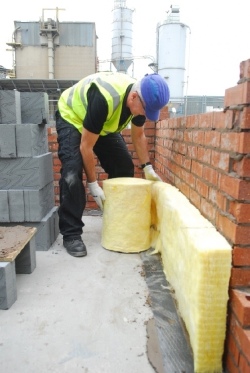The once-in-a-lifetime opportunity

Buildings that adopt a fabric first approach are more likely to achieve energy-efficiency targets, and they are increasingly being valued for the comfort and
building service improvements they can deliver. Stacey Temprell of Saint-Gobain UK explores how a multi-comfort approach can continue to deliver benefits throughout a building’s lifespan.
With April 2014 having signalled the introduction of the changes to Part L, there will again be a shift in focus toward the road to zero-carbon — both within the domestic and non-domestic spheres. For non-domestic buildings, carbon-dioxide targets are strengthened 9% (aggregated over the building mix e.g. 3% for a small warehouse to 12% for hotels) on 2010 standards.
Although there has been some strengthening of specific non-domestic services standards for chillers, fan-coil units and lighting, most of these savings will need to be delivered through cost-effective fabric and service efficiency improvements.
Adopting a multi-comfort approach to the fabric of a building is one such way to secure energy efficiency, whilst helping to go above and beyond Part L targets.
Building on the Passivhaus (or Passive House) principles as defined by the Passivhaus institute and the Passive House Planning Package for delivering the highest thermal comfort and CO2 emissions reduction, Saint-Gobain has applied this standard to its own concept of multi-comfort buildings. By designing additional performance benefits, including providing acoustic and visual comfort measures together with improved internal air quality, fire protection and safety attributes, this approach is not limited to specific products but to clearly defined building performance requirements that provide long-term energy savings and reduced maintenance.
Focusing on the fabric of a building shows the importance of capitalising on the one-time opportunity afforded during the construction phase to use a more sustainable building fabric. But what does this mean for the long-term maintenance, servicing and overall ‘comfort’ of a building and its occupants?
By focusing on the fabric it is possible to reduce the need for energy to heat and cool the building in the first place. After all, the best approach to energy reduction in a building, and therefore a reduction in CO2 emissions, is not to need to use the energy in the first place.
Using less energy can lead to significantly reduced costs for building owners and managers, where, depending on the size and scale of a building, energy can be one of the biggest outlays — not to mention the need to reduce carbon emissions as part of a larger programme of corporate social responsibility (CSR) or in line with Government standards.
Through a combination of high levels of insulation, minimising thermal bridging, super-efficient triple-glazed windows and high standards of air tightness, as well as highly efficient heat-recovery ventilation and general hot-water servicing design, overall heat loss can be significantly reduced.
In its primary function this contributes towards the energy efficiency of a building but importantly it also impacts on the comfort, aiming for optimal thermal comfort during both winter and summer by considering the effect of heat gains through aspects such as window size and orientation. Buildings that are better insulated also create a more stable and controlled environment; reducing the variations in temperature produces a more comfortable space for building users.

Based on the Thermos-flask principle, buildings can maintain a comfortable temperature, as the interior is well protected against the loss of heat whilst the active heat from the outside is supplied in a controlled way. This is achieved using the passive components in a building —including heat-insulating windows, heat-distribution systems and efficient thermal insulation to ensure that the warmth is kept inside.
This approach enables buildings to remain warm during cold periods and prevents overheating during warmer climes, whilst also reducing internal temperature differentials and minimising draughts.
The improved air quality has positive implications for building users, as the regulated humidity this approach delivers not only creates a more comfortable environment but also prevents the growth of mould and risk of dust mites, which can impact on occupants’ health.
However, within commercial and non-residential buildings there are further factors that need to be considered. In addition to the increased size and floor surface area, typically, commercial premises have increased internal heat gains from computers and people, which requires incorporation of thermal mass to reduce daily fluctuations.
Whilst more occupants in non-domestic buildings will have an effect on a building’s heating, their movements will also need to be considered. Commercial buildings are likely to be subject to periodic occupation, and the use of common space and circulated zones, which may not require heating and therefore are thermally separated from occupied spaces, will also impact on the heating and cooling processes.
Once these factors are considered, a multi-comfort approach is designed to deliver more than just energy savings that impact on the overall running costs. It should also improve the well-being of occupants, through factors such as visual and acoustic comfort.
This includes well-designed lighting that is more conducive to a productive working environment and creates visual volumetric clarity, acoustic insulation solutions which can benefit the transmission of sound in meeting and project rooms and systems which can help to reduce the amount of VOCs (volatile organic compounds), significantly improving the air quality and therefore health of building users.
A multi-comfort and other fabric-first approaches are crucial on the road to zero carbon and more sustainable developments for the future. The very nature of these practices is aligned with the new-build sector, and it is important for building services managers to understand the impact these measures will have during the lifetime of a building.
Stacey Temprell is sector director for new build at Saint-Gobain UK.







